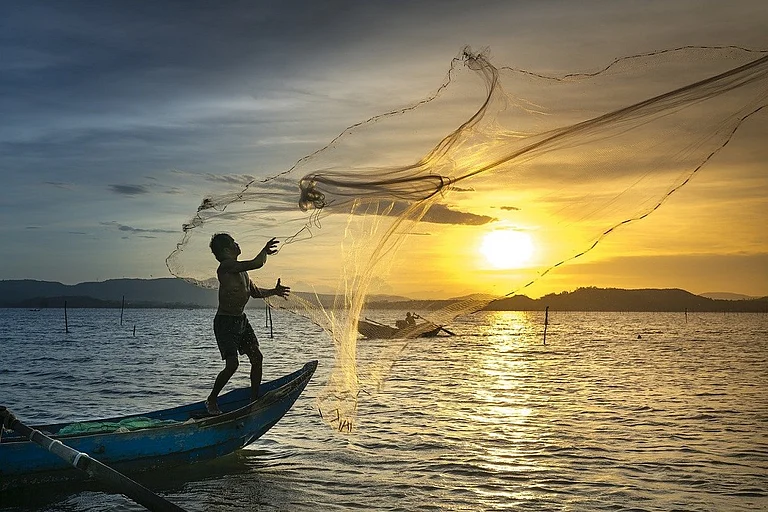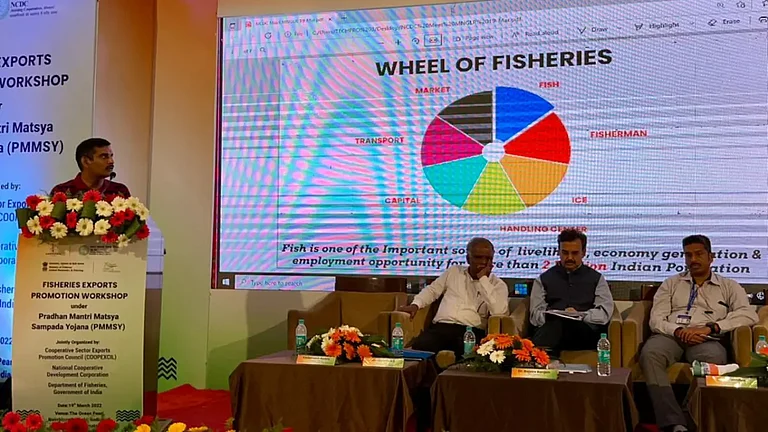Over 35 per cent of India’s shrimp exports are to the US.
20–25 per cent tariff will stall shipments and frozen contracts.
Lakhs of workers on brink of poverty due to wage cuts.
Washington’s Whim Shakes Up India’s Seafood Heartland
The proposed 20 to 26 per cent tariff on marine products, especially shrimp, risk job losses that could send an economic shock along India’s coast.
On a damp monsoon morning in Bhimavaram, the self-proclaimed “Prawn City of India,” the usual bustle inside the peeling sheds is missing. A handful of women sit hunched in freezing rooms, their fingers numb from hours of stripping shells off shrimp packed in melting ice. Outside, farmhands haul up nets from ponds in the Krishna and Godavari deltas. The catch is meagre. Where once the ponds spilled over with harvest, their wiry ropes cutting deep into men’s calloused palms, today, the nets rise half-empty.
Conversations in the coastal towns of Kallakuru, Amalapuram and Bhimavaram are unusually subdued. The mood is not simply about a bad season or a failed crop. It is about an existential fear that the backbone of Andhra Pradesh’s economy—the shrimp trade—may be collapsing.
The cause of this turmoil lies thousands of miles away in Washington, where trade policies are being rewritten for most of the world. A looming threat of steep United States tariffs on Indian marine exports has sent shockwaves across the country’s $8 billion seafood industry stretching from Bengal to Gujarat that sustains lakhs of families along the long coastline. Of all regions, Andhra Pradesh is reeling the hardest.
Industry with Fragile Foundations
India’s dependence on the United States for its shrimp trade is startling. Over 35 per cent of shrimp exports head for its shores, making it the single largest buyer of Indian shrimp. In 2024, nearly 2,60,000 tonnes of Indian shrimp was shipped to American ports, accounting for more than two-fifths of India’s income from seafood exports.
The bulk of this trade rests on a single species: Litopenaeus vannamei, better known as the Pacific whiteleg shrimp—or King prawn. Introduced in India in the late 2000s, it rapidly displaced traditional varieties like the black tiger shrimp, thanks to higher yield, faster growth and uniform size.
But the dependence on vannamei—and on the US market—has created a dangerous situation for Indian exporters. “Despite the large exports, India is at a severe disadvantage,” says Dr K N Raghavan, Secretary-General of the Seafood Exporters Association of India. “Cumulative duties now touch almost 60 per cent, compared with barely 10 to 20 per cent for competitors like Ecuador, Vietnam and Thailand. Exporters who rely only on processing and shipping will find survival impossible. Unless we diversify our markets and add value at home, we face an existential crisis,” he says.
Ecuador’s Rise: India’s Fall
The sharpest blow from Washington’s tariff regime comes from the 26 per cent tariff on Indian shrimp, but barely 10 per cent on Ecuador’s, which has seen a meteoric rise in exports of the item. For American buyers, the choice is obvious. Orders have shifted en masse to Ecuador, leaving Indian exporters with unsold stock and plunging prices.
The temporary halt on tariff escalation by the US has still left scars. In coastal Andhra Pradesh, farm prices of shrimp have crashed. A kilo of 100-count vannamei shrimp, or a one-pound shrimp packet with 100 shrimp) used to fetch ₹290 last year. It now sells for ₹220–₹230, a roughly 20 per drop. Larger 60-count shrimp that once sold for ₹380 barely touch ₹310. For farmers battling rising feed and electricity costs, the math no longer adds up.
The Andhra Pradesh government scrambled to set up a 16-member panel of seafood companies, feed manufacturers and bureaucrats to study Ecuador’s model. The Godavari Delta alone produces 4,00,000 tonnes of shrimp a year, of which 3,50,000 tonnes is exported. With the stakes this high, the committee has been tasked to find a way out—both in terms of immediate relief to workers and producers, and a roadmap for longer term stability.
The Shrimp Pyramid
The shrimp economy in India resembles a precarious pyramid. At the top sit the exporters, including large corporate concerns. In the middle are the pond owners, contractors and feed suppliers. At the very bottom of the pyramid are lakhs of workers—mostly women and migrants from Odisha, Jharkhand and the northeast—who peel, sort and pack shrimp in processing sheds.
“When prices fall steeply, everyone down the chain suffers,” says Shaji Mathew, an exporter. “Once American buyers shift to new suppliers, they rarely return. And the shock of that is borne not just by the exporters but by the poorest women working in our coastal villages.”
The human cost of the crisis is already evident. “The slowdown was felt immediately in this region,” says Kovada Varalakshmi, a fisherwoman leader from Visakhapatnam and president of the Andhra Pradesh Traditional Fish Workers Union. “No export orders means there’s no more peeling work. Many families will take home less than a quarter of their usual pay this month. Children are dropping out of tuition classes. Many women are borrowing from local moneylenders just for groceries.”
Inside the sheds, conditions remain harsh. Women spend hours in cold storage rooms, exposed to icy water and chemicals without protective gear. Many suffer from repetitive strain injuries. Contractors often demand pregnancy tests before hiring and confine migrant women to crowded dormitories. The industry thrives on cheap labour, and in moments of crisis, these workers are treated as expendable.
“Women barely scrape through even in normal times,” says Chennai-based labour researcher Sreedhar Raghavan. “When the sheds close, they are left with nothing. A tariff imposed in Washington may seem like a remote development, but here it translates into skipped meals and hungry kitchens.”
Farmed Prawns Change The Scenario
India’s shrimp farming and export journey was always shaped by global demand. Until the mid-2000s, wild-caught species like Metapenaeus dobsoni and Fenneropenaeus indicus dominated exports. But these were seasonal, inconsistent and the catch was growingly under environmental scrutiny.
At one point, India refuses to mandate Turtle Excluder Devices (TEDs) on trawlers, without which endangered sea turtles routinely drowned in Indian nets. But then US buyers, wary of environmental backlash, shifted away from wild catch and embraced aquaculture. Vannamei became the species of choice, leading to a boom in coastal aquaculture. But the shift has had an unintended consequence: the ecological toll of shrimp farming has boosted opposition to this method.
Across India’s coast, shrimp ponds have replaced mangroves, creeks have turned saline and, in cyclone-prone regions, natural buffers lost. All these have amplified the damage of extreme weather events linked to climate change.
“The vannamei boom has come with an environmental cost that India is yet to acknowledge,” warns coastal rights activist Dr S P Udayakumar from Nagercoil.
Kovada Varalakshmi is blunter: “We lost our creeks and mangroves. Now we have ponds with poisoned water. Those dollars don’t reach us.”
For conservationists, the irony is cruel. Shrimp farming was meant to reduce the pressure on wild catch. Instead, it has deepened ecological fragility while leaving coastal communities poorer and more indebted.
“The new tariff puts us in a complete fix. Importers want us to hold back shipments, while banks are refusing to renew working capital limits,” says Kochi-based exporter Alex Ninan. “Fishermen cannot afford to go out, aquaculture farmers say farming is nearly impossible, wages are rising and environmental opposition is intensifying.”
Shrimp may dominate the headlines, but the tariff threat looms over a much wider basket of exports out of India. Ribbonfish, blue swimming crab meat, lobster tails, squid, cuttlefish, surimi and even ornamental fish could face duties in the future.
At Jude Foods India, a seafood exporter based in Kanyakumari, general manager Gandhi Varadaraj has already been told by his buyers in the US to halt production from March 2026. He now spends his days searching for alternative buyers in Europe and Asia. “We cannot put all our eggs in the US basket anymore,” he says.
The story of Indian shrimp reveals the brutal asymmetry of global trade. In Washington, tariffs are debated as policy levers. In Bhimavaram, they mean empty peeling sheds, idle trawlers and children pulled out of their schools. For American diners, Indian shrimp is an affordable luxury, a tasty appetiser. For Indian workers, each prawn carries a hidden story of frozen hands, vanished mangroves and mounting debt.
The future of India’s shrimp farmers and exporters hinges right now on trade negotiations and how the industry is able to diversity. But for millions living along India’s coast, the crisis is already etched into daily struggles to survive. Fragile ponds grow muddier when the market turns fickle.


